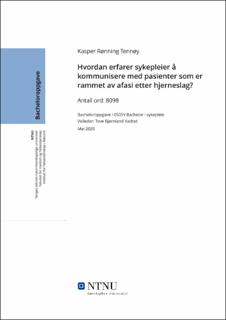| dc.contributor.advisor | Vadset, Tove Bjørnland | |
| dc.contributor.author | Tennøy, Kasper Rønning | |
| dc.date.accessioned | 2020-07-07T16:07:26Z | |
| dc.date.available | 2020-07-07T16:07:26Z | |
| dc.date.issued | 2020 | |
| dc.identifier.uri | https://hdl.handle.net/11250/2661204 | |
| dc.description.abstract | Hensikt: Omtrent 15 000 mennesker rammes årlig av hjerneslag i Norge. Ca. 3000 av disse lever med afasi som følge av hjerneslaget. Målet med denne oppgaven er å belyse hvordan sykepleiere erfarer å kommunisere med pasienter med afasi etter hjerneslag.
Metode: Et systematisk litteratursøk ble gjennomført i databasene CINAHL, Medline, Swemed+ og ProQuest, som inkluderer åtte forskningsartikler som tar for seg hvordan sykepleiere erfarer å kommunisere med pasienter med afasi etter hjerneslag.
Resultat: Funnene i forskningsartiklene viser at det er flere ulike faktorer som virker inn på hvordan sykepleiere erfarer kommunikasjonen med denne pasientgruppen. Funnene ble delt inn i fem hovedkategorier: utdanning og erfaring, hjelpemidler, kroppsspråk, individuell tilnærming og tid og samtalemiljø.
Konklusjon: Det er flere momenter som påvirker hvordan sykepleiere erfarer å kommunisere med afasi etter hjerneslag. De sykepleierne med mer erfaring og utdanning er mer komfortable enn de uten. Nonverbal kommunikasjon er et viktig hjelpemiddel, og herunder finner man hjelpemidler som bilder og tekst, og kroppsspråk som for eksempel blikkontakt og kroppsholdning. Ved å ha en individuell tilnærming til pasienten får man bedre kontinuitet i pleien. Det er også viktig å ha et godt tilrettelagt samtalemiljø uten støy og forstyrrelser, og ta seg god nok tid til å kommunisere med pasienten. | |
| dc.description.abstract | Purpose: An estimated 15 000 Norwegians are affected by strokes every year. Approximately 3000 of these patients live with aphasia as a consequence of the stroke. The purpose of this thesis is to enlighten how nurses experience communicating with patients with aphasia after a stroke.
Method: A systematic literature review was conducted using CINAHL, Medline, Swemed+ and ProQuest databases. The literature review includes eight research articles which studies how nurses experience communications with patients suffering from aphasia following strokes.
Results: The studies’ findings revealed that several factors affect how nurses communicate with these patients. The findings were categorized in these five categories: experience and education, communication aids, body language, individual approach and time and conversational environment.
Conclusion: Numerous aspects affect nurses’ experience of communicating with patients suffering from aphasia. The nurses with the most experience and education are more comfortable than the nurses without experience. Nonverbal communication is an important aid. This includes aids such as pictures and written text, and body language such as eye contact and body positioning. By taking an individual approach to each patient one gets better continuity of the care. A well suited conversational environment without disruptions and taking enough time to communicate with the patient is also important. | |
| dc.publisher | NTNU | |
| dc.title | Hvordan erfarer sykepleier å kommunisere med pasienter som er rammet av afasi etter hjerneslag? | |
| dc.type | Bachelor thesis | |
